Pumping Station Desing - Second Edition by Robert L. Sanks, George Tchobahoglous, Garr M. Jones
Подождите немного. Документ загружается.

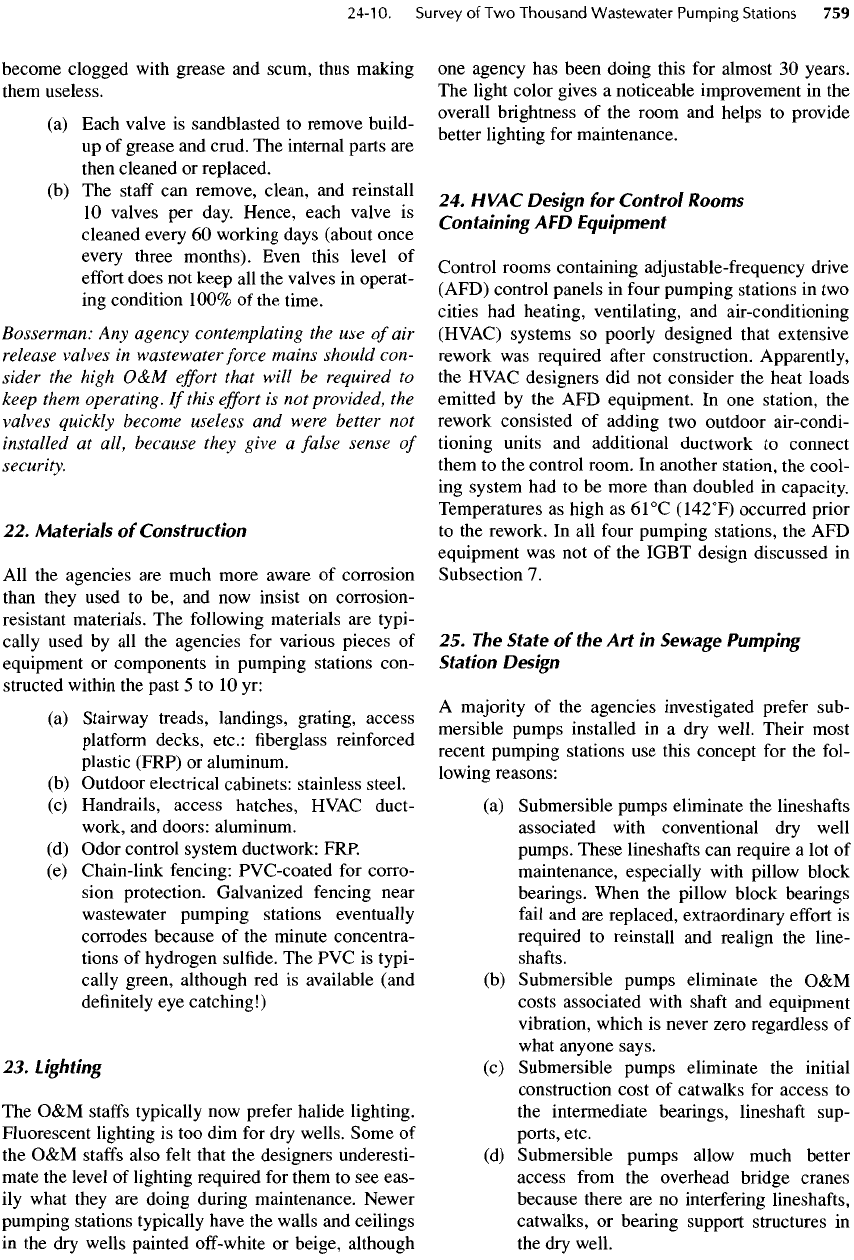
become clogged with grease
and
scum, thus making
them
useless.
(a)
Each valve
is
sandblasted
to
remove build-
up
of
grease
and
crud.
The
internal parts
are
then
cleaned
or
replaced,
(b)
The
staff
can
remove, clean,
and
reinstall
10
valves
per
day. Hence, each valve
is
cleaned every
60
working days (about once
every
three months). Even this level
of
effort
does
not
keep
all the
valves
in
operat-
ing
condition 100%
of the
time.
Bosserman:
Any
agency contemplating
the use
of
air
release
valves
in
wastewater
force mains should con-
sider
the
high
O&M
effort
that will
be
required
to
keep
them operating.
If
this
effort
is not
provided,
the
valves
quickly become useless
and
were
better
not
installed
at
all,
because
they
give
a
false sense
of
security.
22.
Materials
of
Construction
All
the
agencies
are
much more aware
of
corrosion
than
they used
to be, and now
insist
on
corrosion-
resistant
materials.
The
following materials
are
typi-
cally
used
by all the
agencies
for
various pieces
of
equipment
or
components
in
pumping stations con-
structed
within
the
past
5 to
1
0
yr:
(a)
Stairway treads, landings, grating, access
platform
decks, etc.:
fiberglass
reinforced
plastic
(FRP)
or
aluminum,
(b)
Outdoor electrical cabinets: stainless steel.
(c)
Handrails, access hatches,
HVAC
duct-
work,
and
doors:
aluminum,
(d)
Odor control system ductwork: FRP.
(e)
Chain-link fencing:
PVC-coated
for
corro-
sion
protection. Galvanized fencing near
wastewater
pumping stations eventually
corrodes because
of the
minute concentra-
tions
of
hydrogen
sulfide.
The PVC is
typi-
cally
green, although
red is
available (and
definitely
eye
catching!)
23.
Lighting
The O&M
staffs
typically
now
prefer
halide
lighting.
Fluorescent lighting
is too dim for dry
wells. Some
of
the O&M
staffs
also
felt
that
the
designers underesti-
mate
the
level
of
lighting required
for
them
to see
eas-
ily
what they
are
doing during maintenance. Newer
pumping
stations typically have
the
walls
and
ceilings
in
the dry
wells painted
off-white
or
beige, although
one
agency
has
been doing this
for
almost
30
years.
The
light color gives
a
noticeable improvement
in the
overall brightness
of the
room
and
helps
to
provide
better lighting
for
maintenance.
24.
HVAC
Design
for
Control Rooms
Containing
AFD
Equipment
Control rooms containing adjustable-frequency drive
(AFD) control panels
in
four
pumping stations
in two
cities
had
heating, ventilating,
and
air-conditioning
(HVAC)
systems
so
poorly designed that extensive
rework
was
required
after
construction. Apparently,
the
HVAC designers
did not
consider
the
heat loads
emitted
by the AFD
equipment.
In one
station,
the
rework consisted
of
adding
two
outdoor air-condi-
tioning
units
and
additional ductwork
to
connect
them
to the
control room.
In
another station,
the
cool-
ing
system
had to be
more than doubled
in
capacity.
Temperatures
as
high
as
61
0
C
(142
0
F)
occurred prior
to the
rework.
In all
four
pumping stations,
the AFD
equipment
was not of the
IGBT design discussed
in
Subsection
7.
25. The
State
of
the Art in
Sewage
Pumping
Station
Design
A
majority
of the
agencies
investigated prefer sub-
mersible pumps installed
in a dry
well. Their most
recent pumping stations
use
this concept
for the
fol-
lowing
reasons:
(a)
Submersible pumps eliminate
the
lineshafts
associated with conventional
dry
well
pumps.
These lineshafts
can
require
a lot of
maintenance,
especially
with pillow block
bearings. When
the
pillow block bearings
fail
and are
replaced, extraordinary
effort
is
required
to
reinstall
and
realign
the
line-
shafts,
(b)
Submersible pumps eliminate
the O&M
costs associated with
shaft
and
equipment
vibration, which
is
never zero regardless
of
what
anyone
says,
(c)
Submersible pumps eliminate
the
initial
construction cost
of
catwalks
for
access
to
the
intermediate
bearings, lineshaft sup-
ports, etc.
(d)
Submersible pumps allow much
better
access
from
the
overhead bridge cranes
because there
are no
interfering lineshafts,
catwalks,
or
bearing support structures
in
the
dry
well.
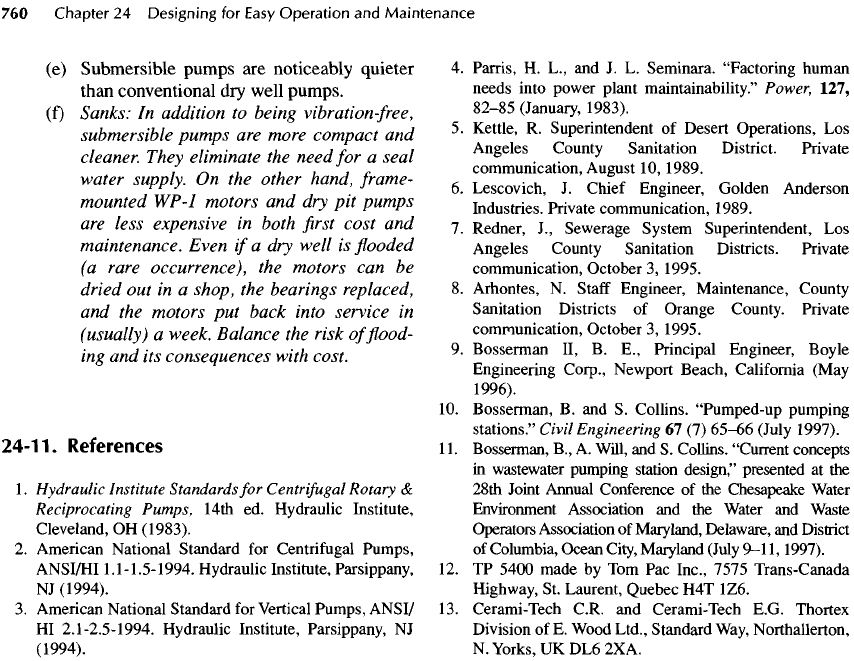
(e)
Submersible pumps
are
noticeably quieter
than
conventional
dry
well
pumps,
(f)
Sanks:
In
addition
to
being
vibration-free,
submersible
pumps
are
more
compact
and
cleaner.
They
eliminate
the
need
for a
seal
water
supply.
On the
other
hand,
frame-
mounted
WP-I
motors
and dry pit
pumps
are
less
expensive
in
both
first
cost
and
maintenance.
Even
if
a dry
well
is flooded
(a
rare
occurrence),
the
motors
can be
dried
out in a
shop,
the
bearings
replaced,
and
the
motors
put
back
into
service
in
(usually)
a
week.
Balance
the
risk
of flood-
ing
and its
consequences
with cost.
24-11.
References
1
.
Hydraulic Institute
Standards
for
Centrifugal
Rotary
&
Reciprocating
Pumps,
14th
ed.
Hydraulic Institute,
Cleveland,
OH
(1983).
2.
American National Standard
for
Centrifugal Pumps,
ANSI/HI
1.1-1.5-1994. Hydraulic Institute, Parsippany,
NJ
(1994).
3.
American National Standard
for
Vertical Pumps, ANSI/
HI
2.1-2.5-1994.
Hydraulic Institute, Parsippany,
NJ
(1994).
4.
Parris,
H.
L.,
and J. L.
Seminara.
"Factoring
human
needs into power plant maintainability." Power,
127,
82-85
(January,
1983).
5.
Kettle,
R.
Superintendent
of
Desert Operations,
Los
Angeles County Sanitation District. Private
communication, August
10,
1989.
6.
Lescovich,
J.
Chief Engineer, Golden Anderson
Industries. Private communication,
1989.
7.
Redner,
J.,
Sewerage
System Superintendent,
Los
Angeles County Sanitation Districts. Private
communication,
October
3,
1995.
8.
Arhontes,
N.
Staff
Engineer, Maintenance, County
Sanitation Districts
of
Orange County. Private
communication, October
3,
1995.
9.
Bosserman
II, B.
E.,
Principal
Engineer, Boyle
Engineering Corp., Newport Beach, California
(May
1996).
10.
Bosserman,
B. and S.
Collins.
"Pumped-up
pumping
stations." Civil Engineering
67 (7)
65-66
(July 1997).
11.
Bosserman,
B.,
A.
Will,
and S.
Collins. "Current concepts
in
wastewater pumping station design," presented
at the
28th Joint Annual Conference
of the
Chesapeake Water
Environment
Association
and the
Water
and
Waste
Operators Association
of
Maryland, Delaware,
and
District
of
Columbia, Ocean City, Maryland (July
9-11,
1997).
12.
TP
5400
made
by Tom Pac
Inc.,
7575 Trans-Canada
Highway,
St.
Laurent, Quebec
H4T
1Z6.
13.
Cerami-Tech
C.R.
and
Cerami-Tech
E.G.
Thortex
Division
of E.
Wood
Ltd.,
Standard Way,
Northallerton,
N.Yorks,UKDL62XA.
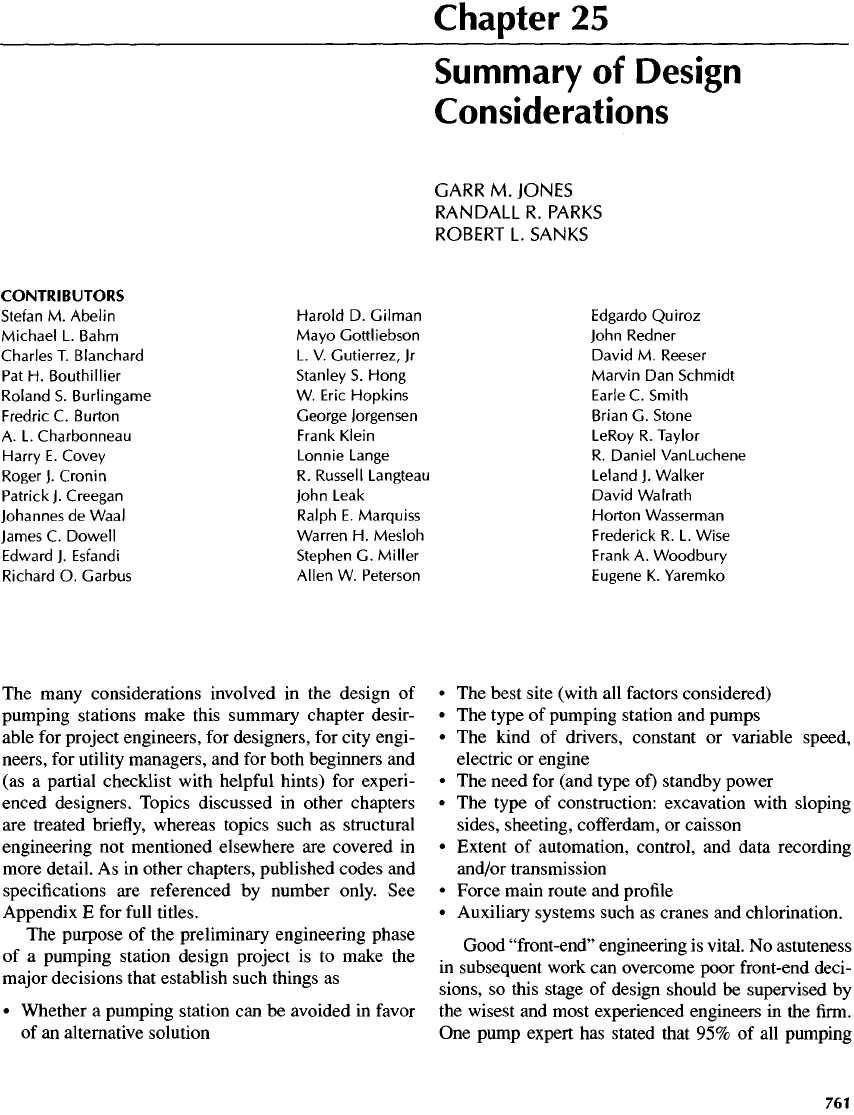
CONTRIBUTORS
Stefan
M.
Abelin
Harold
D.
Oilman
Michael
L.
Bahm
Mayo
Gottliebson
Charles
T.
Blanchard
L. V.
Gutierrez,
Jr
Pat H.
Bouthillier
Stanley
S.
Hong
Roland
S.
Burlingame
W.
Eric
Hopkins
Fredric
C.
Burton
George
Jorgensen
A. L.
Charbonneau
Frank
Klein
Harry
E.
Covey
Lonnie
Lange
Roger
J.
Cronin
R.
Russell
Langteau
Patrick].
Creegan
John
Leak
Johannes
de
Waal
Ralph
E.
Marquiss
James
C.
Dowel!
Warren
H.
Mesloh
Edward
J.
Esfandi
Stephen
G.
Miller
Richard
O.
Garbus
Allen
W.
Peterson
The
many considerations involved
in the
design
of
pumping
stations make this summary chapter desir-
able
for
project engineers,
for
designers,
for
city engi-
neers,
for
utility managers,
and for
both beginners
and
(as a
partial checklist with
helpful
hints)
for
experi-
enced designers. Topics discussed
in
other chapters
are
treated
briefly,
whereas topics such
as
structural
engineering
not
mentioned elsewhere
are
covered
in
more detail.
As in
other chapters, published codes
and
specifications
are
referenced
by
number only.
See
Appendix
E for
full
titles.
The
purpose
of the
preliminary engineering phase
of
a
pumping station design project
is to
make
the
major
decisions that establish such things
as
•
Whether
a
pumping station
can be
avoided
in
favor
of
an
alternative solution
Chapter
25
Summary
of
Design
Considerations
GARR
M.
JONES
RANDALL
R.
PARKS
ROBERT
L.
SANKS
Edgardo
Quiroz
John
Redner
David
M.
Reeser
Marvin
Dan
Schmidt
Earle
C.
Smith
Brian
G.
Stone
LeRoy
R.
Taylor
R.
Daniel
VanLuchene
Leland
J.
Walker
David
WaI
rath
Morton
Wasserman
Frederick
R. L.
Wise
Frank
A.
Woodbury
Eugene
K.
Yaremko
• The
best site (with
all
factors
considered)
• The
type
of
pumping station
and
pumps
• The
kind
of
drivers, constant
or
variable speed,
electric
or
engine
• The
need
for
(and type
of)
standby power
• The
type
of
construction: excavation with sloping
sides, sheeting,
cofferdam,
or
caisson
•
Extent
of
automation, control,
and
data recording
and/or transmission
•
Force
main route
and
profile
•
Auxiliary systems such
as
cranes
and
chlorination.
Good "front-end" engineering
is
vital.
No
astuteness
in
subsequent work
can
overcome poor
front-end
deci-
sions,
so
this stage
of
design should
be
supervised
by
the
wisest
and
most experienced engineers
in the firm.
One
pump expert
has
stated that
95% of all
pumping
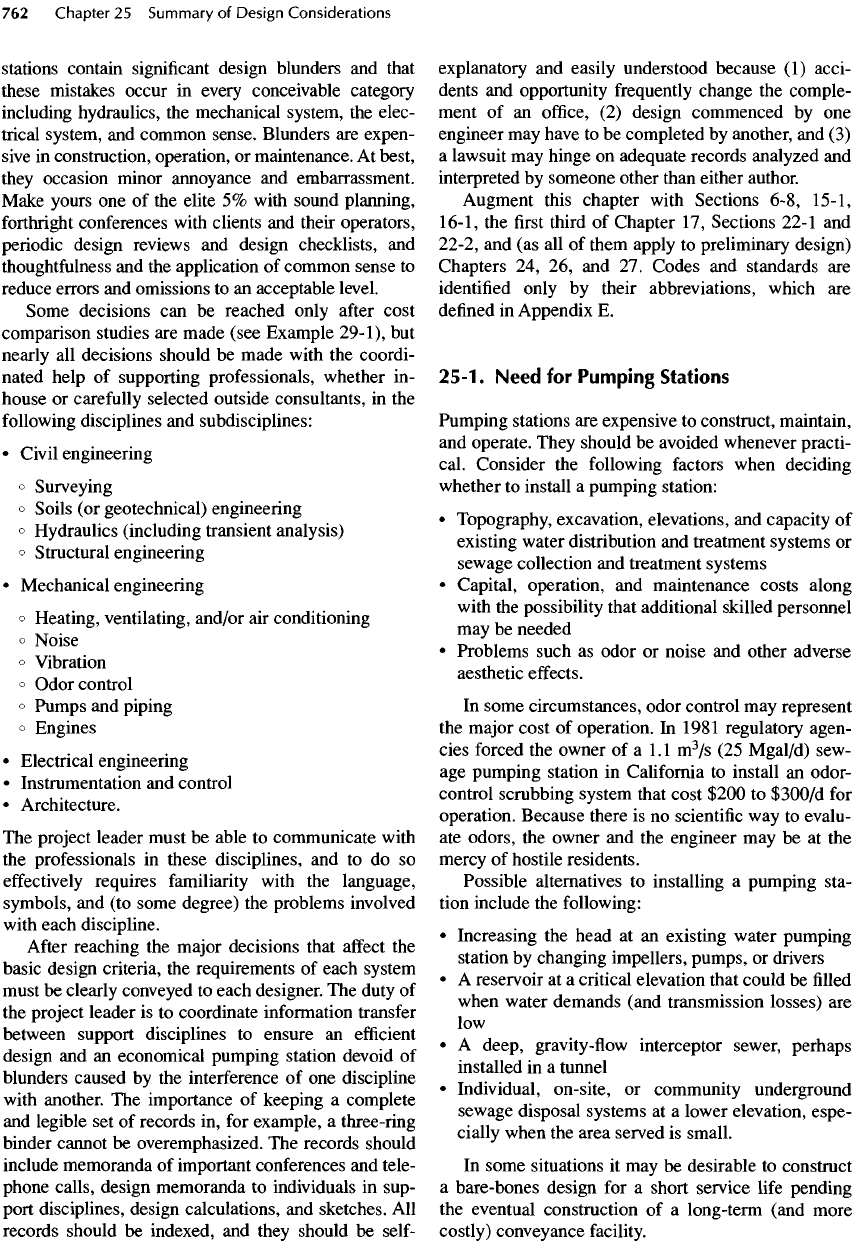
stations contain significant design blunders
and
that
these mistakes occur
in
every conceivable category
including
hydraulics,
the
mechanical system,
the
elec-
trical system,
and
common sense. Blunders
are
expen-
sive
in
construction, operation,
or
maintenance.
At
best,
they
occasion minor annoyance
and
embarrassment.
Make
yours
one of the
elite
5%
with sound planning,
forthright
conferences with clients
and
their operators,
periodic design reviews
and
design checklists,
and
thoughtfulness
and the
application
of
common sense
to
reduce errors
and
omissions
to an
acceptable level.
Some decisions
can be
reached only
after
cost
comparison studies
are
made (see Example 29-1),
but
nearly
all
decisions should
be
made with
the
coordi-
nated
help
of
supporting professionals, whether
in-
house
or
carefully
selected outside consultants,
in the
following
disciplines
and
subdisciplines:
•
Civil engineering
°
Surveying
°
Soils
(or
geotechnical) engineering
°
Hydraulics (including transient analysis)
°
Structural engineering
•
Mechanical engineering
°
Heating, ventilating, and/or
air
conditioning
°
Noise
°
Vibration
°
Odor control
°
Pumps
and
piping
°
Engines
•
Electrical engineering
•
Instrumentation
and
control
•
Architecture.
The
project leader must
be
able
to
communicate with
the
professionals
in
these disciplines,
and to do so
effectively
requires familiarity with
the
language,
symbols,
and (to
some degree)
the
problems involved
with
each discipline.
After
reaching
the
major
decisions that
affect
the
basic design criteria,
the
requirements
of
each system
must
be
clearly conveyed
to
each designer.
The
duty
of
the
project leader
is to
coordinate information transfer
between support disciplines
to
ensure
an
efficient
design
and an
economical pumping station devoid
of
blunders
caused
by the
interference
of one
discipline
with
another.
The
importance
of
keeping
a
complete
and
legible
set of
records
in, for
example,
a
three-ring
binder cannot
be
overemphasized.
The
records should
include memoranda
of
important conferences
and
tele-
phone
calls,
design
memoranda
to
individuals
in
sup-
port disciplines, design calculations,
and
sketches.
All
records should
be
indexed,
and
they should
be
self-
explanatory
and
easily understood because
(1)
acci-
dents
and
opportunity
frequently
change
the
comple-
ment
of an
office,
(2)
design commenced
by one
engineer
may
have
to be
completed
by
another,
and (3)
a
lawsuit
may
hinge
on
adequate records analyzed
and
interpreted
by
someone other than either author.
Augment
this chapter with Sections 6-8, 15-1,
16-1,
the first
third
of
Chapter
17,
Sections 22-1
and
22-2,
and (as all of
them apply
to
preliminary design)
Chapters
24, 26, and 27.
Codes
and
standards
are
identified
only
by
their abbreviations, which
are
defined
in
Appendix
E.
25-1
.
Need
for
Pumping
Stations
Pumping stations
are
expensive
to
construct, maintain,
and
operate. They should
be
avoided whenever practi-
cal. Consider
the
following factors when deciding
whether
to
install
a
pumping station:
•
Topography, excavation, elevations,
and
capacity
of
existing water distribution
and
treatment systems
or
sewage
collection
and
treatment systems
•
Capital,
operation,
and
maintenance costs along
with
the
possibility that additional skilled personnel
may
be
needed
•
Problems such
as
odor
or
noise
and
other adverse
aesthetic
effects.
In
some circumstances, odor
control
may
represent
the
major
cost
of
operation.
In
1981
regulatory agen-
cies forced
the
owner
of a
1.1
m
3
/s
(25
Mgal/d)
sew-
age
pumping station
in
California
to
install
an
odor-
control scrubbing system that cost
$200
to
$300/d
for
operation. Because there
is no
scientific
way to
evalu-
ate
odors,
the
owner
and the
engineer
may be at the
mercy
of
hostile residents.
Possible
alternatives
to
installing
a
pumping sta-
tion
include
the
following:
•
Increasing
the
head
at an
existing water pumping
station
by
changing
impellers,
pumps,
or
drivers
• A
reservoir
at a
critical elevation that could
be filled
when
water demands (and transmission
losses)
are
low
• A
deep,
gravity-flow
interceptor sewer, perhaps
installed
in a
tunnel
•
Individual, on-site,
or
community underground
sewage
disposal systems
at a
lower elevation, espe-
cially when
the
area served
is
small.
In
some situations
it may be
desirable
to
construct
a
bare-bones
design
for a
short
service
life
pending
the
eventual construction
of a
long-term (and more
costly) conveyance facility.
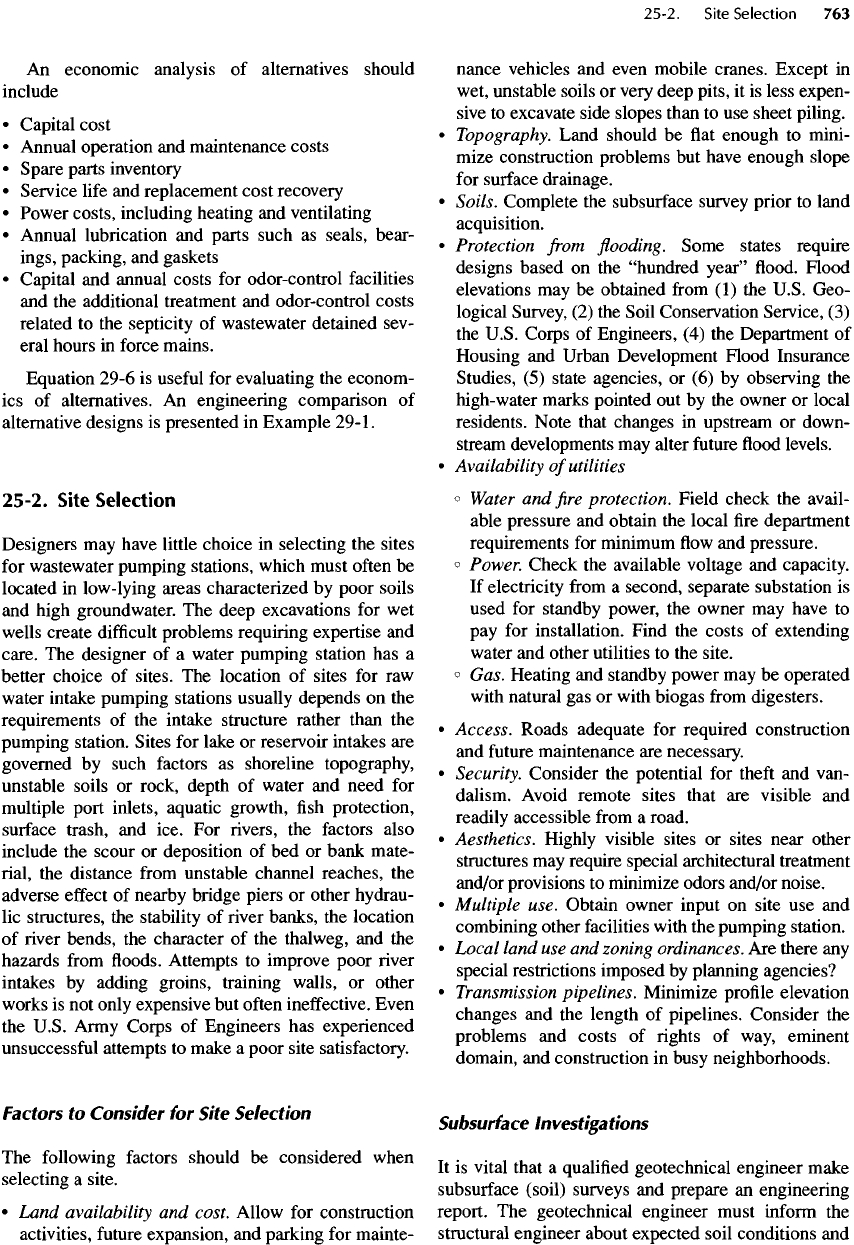
An
economic analysis
of
alternatives should
include
•
Capital cost
•
Annual operation
and
maintenance costs
•
Spare parts inventory
•
Service
life
and
replacement cost recovery
•
Power costs, including heating
and
ventilating
•
Annual lubrication
and
parts such
as
seals, bear-
ings, packing,
and
gaskets
•
Capital
and
annual costs
for
odor-control facilities
and
the
additional treatment
and
odor-control costs
related
to the
septicity
of
wastewater detained sev-
eral hours
in
force mains.
Equation 29-6
is
useful
for
evaluating
the
econom-
ics of
alternatives.
An
engineering comparison
of
alternative designs
is
presented
in
Example
29-1.
25-2. Site Selection
Designers
may
have little choice
in
selecting
the
sites
for
wastewater pumping stations, which must
often
be
located
in
low-lying areas characterized
by
poor soils
and
high groundwater.
The
deep excavations
for wet
wells create
difficult
problems requiring expertise
and
care.
The
designer
of a
water pumping station
has a
better choice
of
sites.
The
location
of
sites
for raw
water
intake pumping stations usually depends
on the
requirements
of the
intake structure rather than
the
pumping station. Sites
for
lake
or
reservoir intakes
are
governed
by
such factors
as
shoreline topography,
unstable soils
or
rock, depth
of
water
and
need
for
multiple port inlets, aquatic growth,
fish
protection,
surface
trash,
and
ice.
For rivers, the
factors also
include
the
scour
or
deposition
of bed or
bank mate-
rial, the
distance
from
unstable channel reaches,
the
adverse
effect
of
nearby bridge piers
or
other hydrau-
lic
structures,
the
stability
of river
banks,
the
location
of
river
bends,
the
character
of the
thalweg,
and the
hazards
from
floods.
Attempts
to
improve poor
river
intakes
by
adding groins, training walls,
or
other
works
is not
only expensive
but
often
ineffective. Even
the
U.S. Army Corps
of
Engineers
has
experienced
unsuccessful
attempts
to
make
a
poor site satisfactory.
Factors
to
Consider
for
Site
Selection
The
following factors should
be
considered when
selecting
a
site.
•
Land availability
and
cost. Allow
for
construction
activities,
future
expansion,
and
parking
for
mainte-
nance vehicles
and
even mobile cranes. Except
in
wet,
unstable soils
or
very deep pits,
it is
less expen-
sive
to
excavate side slopes than
to use
sheet piling.
•
Topography.
Land should
be flat
enough
to
mini-
mize construction problems
but
have enough slope
for
surface drainage.
•
Soils. Complete
the
subsurface survey prior
to
land
acquisition.
•
Protection
from flooding.
Some states require
designs based
on the
"hundred
year"
flood.
Flood
elevations
may be
obtained
from
(1) the
U.S. Geo-
logical Survey,
(2) the
Soil Conservation Service,
(3)
the
U.S. Corps
of
Engineers,
(4) the
Department
of
Housing
and
Urban Development Flood Insurance
Studies,
(5)
state agencies,
or (6) by
observing
the
high-water
marks pointed
out by the
owner
or
local
residents. Note that changes
in
upstream
or
down-
stream developments
may
alter
future
flood
levels.
•
Availability
of
utilities
°
Water
and fire
protection.
Field
check
the
avail-
able pressure
and
obtain
the
local
fire
department
requirements
for
minimum
flow and
pressure.
°
Power. Check
the
available voltage
and
capacity.
If
electricity
from
a
second, separate substation
is
used
for
standby power,
the
owner
may
have
to
pay
for
installation. Find
the
costs
of
extending
water
and
other utilities
to the
site.
°
Gas. Heating
and
standby power
may be
operated
with
natural
gas or
with biogas
from
digesters.
•
Access. Roads adequate
for
required construction
and
future
maintenance
are
necessary.
•
Security. Consider
the
potential
for
theft
and
van-
dalism. Avoid remote sites that
are
visible
and
readily accessible
from
a
road.
•
Aesthetics. Highly visible sites
or
sites near other
structures
may
require special architectural treatment
and/or provisions
to
minimize odors and/or noise.
•
Multiple
use. Obtain owner input
on
site
use and
combining other facilities with
the
pumping station.
•
Local
land
use and
zoning ordinances.
Are
there
any
special restrictions imposed
by
planning agencies?
•
Transmission pipelines. Minimize
profile
elevation
changes
and the
length
of
pipelines. Consider
the
problems
and
costs
of rights of
way, eminent
domain,
and
construction
in
busy neighborhoods.
Subsurface
Investigations
It
is
vital that
a
qualified
geotechnical engineer make
subsurface
(soil) surveys
and
prepare
an
engineering
report.
The
geotechnical engineer must inform
the
structural engineer about expected
soil
conditions
and
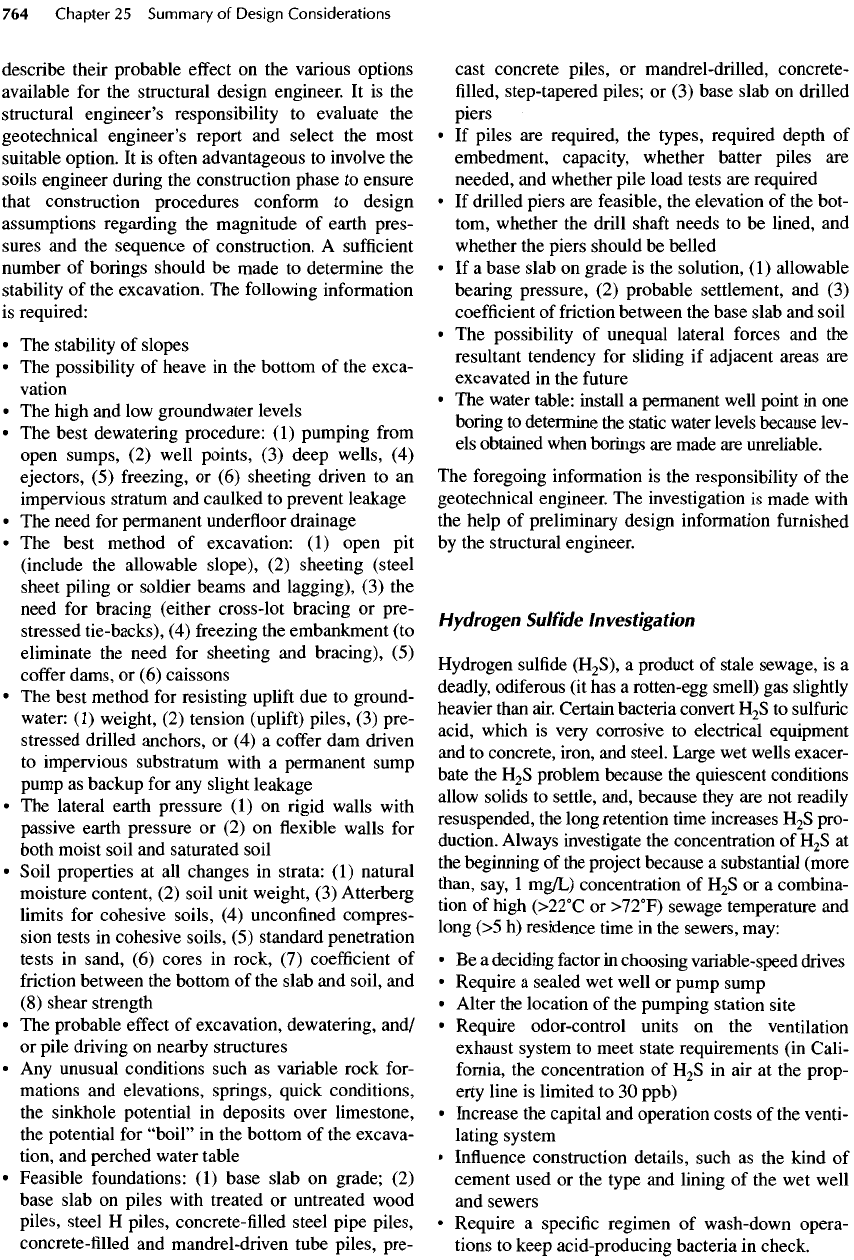
describe their probable
effect
on the
various options
available
for the
structural design engineer.
It is the
structural
engineer's responsibility
to
evaluate
the
geotechnical engineer's report
and
select
the
most
suitable option.
It is
often
advantageous
to
involve
the
soils engineer during
the
construction phase
to
ensure
that
construction procedures conform
to
design
assumptions
regarding
the
magnitude
of
earth pres-
sures
and the
sequence
of
construction.
A
sufficient
number
of
borings should
be
made
to
determine
the
stability
of the
excavation.
The
following information
is
required:
• The
stability
of
slopes
• The
possibility
of
heave
in the
bottom
of the
exca-
vation
• The
high
and low
groundwater levels
• The
best dewatering procedure:
(1)
pumping
from
open sumps,
(2)
well points,
(3)
deep wells,
(4)
ejectors,
(5)
freezing,
or (6)
sheeting driven
to an
impervious stratum
and
caulked
to
prevent leakage
• The
need
for
permanent
underfloor
drainage
• The
best method
of
excavation:
(1)
open
pit
(include
the
allowable slope),
(2)
sheeting (steel
sheet
piling
or
soldier beams
and
lagging),
(3) the
need
for
bracing (either
cross-lot
bracing
or
pre-
stressed tie-backs),
(4)
freezing
the
embankment
(to
eliminate
the
need
for
sheeting
and
bracing),
(5)
coffer
dams,
or (6)
caissons
• The
best method
for
resisting
uplift
due to
ground-
water:
(1)
weight,
(2)
tension
(uplift)
piles,
(3)
pre-
stressed drilled anchors,
or (4) a
coffer
dam
driven
to
impervious substratum with
a
permanent sump
pump
as
backup
for any
slight leakage
• The
lateral earth pressure
(1) on
rigid walls with
passive earth pressure
or (2) on flexible
walls
for
both moist soil
and
saturated soil
•
Soil properties
at all
changes
in
strata:
(1)
natural
moisture content,
(2)
soil unit weight,
(3)
Atterberg
limits
for
cohesive soils,
(4)
unconfined
compres-
sion
tests
in
cohesive soils,
(5)
standard penetration
tests
in
sand,
(6)
cores
in
rock,
(7)
coefficient
of
friction
between
the
bottom
of the
slab
and
soil,
and
(8)
shear strength
• The
probable
effect
of
excavation, dewatering, and/
or
pile driving
on
nearby structures
• Any
unusual
conditions such
as
variable rock for-
mations
and
elevations, springs, quick conditions,
the
sinkhole potential
in
deposits over limestone,
the
potential
for
"boil"
in the
bottom
of the
excava-
tion,
and
perched water table
•
Feasible foundations:
(1)
base slab
on
grade;
(2)
base slab
on
piles
with
treated
or
untreated wood
piles, steel
H
piles, concrete-filled steel pipe piles,
concrete-filled
and
mandrel-driven tube piles, pre-
cast concrete
piles,
or
mandrel-drilled, concrete-
filled,
step-tapered
piles;
or (3)
base slab
on
drilled
piers
• If
piles
are
required,
the
types, required depth
of
embedment, capacity, whether batter piles
are
needed,
and
whether
pile
load tests
are
required
• If
drilled piers
are
feasible,
the
elevation
of the
bot-
tom, whether
the
drill
shaft
needs
to be
lined,
and
whether
the
piers should
be
belled
• If a
base slab
on
grade
is the
solution,
(1)
allowable
bearing pressure,
(2)
probable settlement,
and (3)
coefficient
of
friction
between
the
base slab
and
soil
• The
possibility
of
unequal
lateral
forces
and the
resultant tendency
for
sliding
if
adjacent areas
are
excavated
in the
future
• The
water table: install
a
permanent well point
in one
boring
to
determine
the
static water levels because lev-
els
obtained when borings
are
made
are
unreliable.
The
foregoing information
is the
responsibility
of the
geotechnical engineer.
The
investigation
is
made with
the
help
of
preliminary design information
furnished
by
the
structural engineer.
Hydrogen
Sulfide
Investigation
Hydrogen
sulfide
(H
2
S),
a
product
of
stale sewage,
is a
deadly, odiferous
(it has a
rotten-egg smell)
gas
slightly
heavier than air. Certain bacteria convert
H
2
S
to
sulfuric
acid, which
is
very corrosive
to
electrical equipment
and
to
concrete, iron,
and
steel.
Large
wet
wells exacer-
bate
the
H
2
S
problem because
the
quiescent conditions
allow
solids
to
settle, and, because they
are not
readily
resuspended,
the
long retention time increases
H
2
S
pro-
duction. Always investigate
the
concentration
of
H
2
S
at
the
beginning
of the
project because
a
substantial (more
than,
say,
1
mg/L)
concentration
of
H
2
S
or a
combina-
tion
of
high
(>22°C
or
>72°F) sewage temperature
and
long
(>5 h)
residence time
in the
sewers, may:
• Be a
deciding
factor
in
choosing variable-speed drives
•
Require
a
sealed
wet
well
or
pump sump
•
Alter
the
location
of the
pumping station site
•
Require odor-control units
on the
ventilation
exhaust
system
to
meet state requirements
(in
Cali-
fornia,
the
concentration
of
H
2
S
in air at the
prop-
erty
line
is
limited
to 30
ppb)
•
Increase
the
capital
and
operation costs
of the
venti-
lating
system
•
Influence
construction details, such
as the
kind
of
cement used
or the
type
and
lining
of the wet
well
and
sewers
•
Require
a
specific
regimen
of
wash-down opera-
tions
to
keep acid-producing bacteria
in
check.

25-3.
Architectural
and
Environmental
Considerations
Before
the
pumping station design
is
begun, make
sure
all the
environmental
considerations
are met and
public
hearings have been held.
The
site should
be
checked
for
archaeological
findings,
and
local
and
state regulatory agencies that
may
have jurisdiction
should
be
consulted. Become acquainted with
the
per-
tinent codes (see
the
subsection
on
Chapter
25 in
Appendix
E).
Local planning agencies
are
likely
to
require
review
and
approval
of
plans. Discussions with
the
owner,
the
local residents,
and the
planning agency
are
useful
in
determining
the
style
of
building
to be
used. Consider using
a
consulting architect
if one is
not
available
in
house.
In
general,
the
cost
of
architec-
tural
treatment
is
minor;
one
expert estimated
the
cost
to be
less
than
2% of the
construction
cost.
Others
maintain that
it is
often
difficult
to
determine whether
architectural treatment costs anything.
Aesthetics
For the
most part, utility installations should
not be
seen, heard,
or
detected
in any way
that would
degrade
the
local environment.
To
that end,
the
design
should
include
the
following features:
•
Archetectural design that blends into
the
neighbor-
hood
and
neither establishes
a
presence
that
declares
the
purpose
of the
installation
nor
degrades
the
property value
of its
neighbors. Pumping station
superstructures,
with minimal
effort
and
expense,
can
be
easily
be
crafted
to
appear
to be
homes,
farmhouses,
or
restaurants (see Figure
25-1).
• As
alternatives, pumping stations
can
either
be
con-
cealed
by
burial (with
the
exception
of
electrical
and
instrumentation equipment, which must
be
pro-
tected
from
flooding),
partly concealed
by
land-
scaping,
or
made into attractive architectural
features.
Landscaping plans that minimize mainte-
nance should
be
developed
by a
landscape architect.
•
Noise
and
light emissions should
be
suppressed
to
avoid
broadcasting
the
function
of the
installation.
Special construction
features
can be
included
to
vir-
tually
eliminate
the
high-frequency noise
from
motors. Hospital-grade silencers
are
available
for
engines
at
little additional cost. With diligence,
the
noise
from
ventilation equipment
can be
sup-
pressed. Lighting
fixtures in a
variety
of
architectur-
ally
acceptable designs
are
available
to
illuminate
exterior areas without suggesting
a
commercial
or
industrial
facility.
• For
wastewater stations, odor control
and
treatment
are
perhaps
the
most
challenging
environmental
management tasks.
The
design should incorporate
every technique
for
avoiding
the
conditions that
generate
odors.
A
variety
of
cost-effective
and
sim-
ple
treatment techniques
are
available.
Hazardous
Areas
An
unventilated
or
sealed wastewater pumping station
wet
well
is
rated
as a
Class
A
Confined
Space.
Because
of the
extreme danger
of
explosion,
flamma-
bility, toxic gases,
and
oxygen deficiency,
it can be
entered only under stringent regulations (see Section
23-1).
If the wet
well contains
electrical
equipment,
it
is
rated
by NEC
standards
as a
Class
1,
Division
1
hazardous
space when
flammable or
explosive gases
are
normally present,
as in an
unventilated space.
However,
if flammable
gases
are
absent except under
abnormal conditions (e.g.,
failure
of
ventilation sys-
tem),
the wet
well
is
rated
as a
Class
1,
Division
2
space.
All
electrical equipment
and
devices
in
Class
1,
Division
1
spaces must
be
explosionproof, whereas
in
Class
1,
Division
2
spaces, only
arc
-producing
equip-
ment
(e.g., switches with external contacts) must
be
explosionproof.
(A
squirrel-cage motor
in a
Class
1,
Division
1
space must
be in an
explosionproof
enclo-
sure,
whereas
it can be in an
open,
dripproof
enclosure
in
a
Class
1
Division
2
space
as
long
as it is not
equipped with switches.) Division
1
spaces
in wet
wells
can be
avoided (except below
the
grating)
by
installing
a
ventilation system that always operates
at
12
air
changes
per
hour
or
more (see Section 23-2).
The
ratings
of the
various areas must
be
decided
in
conjunction
with
the
authority having
jurisdiction
—
the
local
or
state
electrical
inspector.
A
dry
well with access
to a wet
well also becomes
a
Class
1,
Division
1 or
Division
2
hazardous space,
and
such access should never
be
tolerated
in new
con-
struction
nor
should
it be
allowed
in an
existing pump-
ing
station being remodeled. Access
to a wet
well
should
be
possible only through
an
outside door.
Ventilation
Sewer
gas is
deadly.
The
safety
of
personnel
who
must
enter pumping stations should
not be
compro-
mised, especially
if
they must enter
wet
wells. Codes
require
a
certain number
of air
changes
per
hour,
and
minimums
are
shown
in
Table 25-1. However, some
states require
a
higher rate
of
ventilation and,
if the
wastewater
is
stale,
so
should prudent engineers.
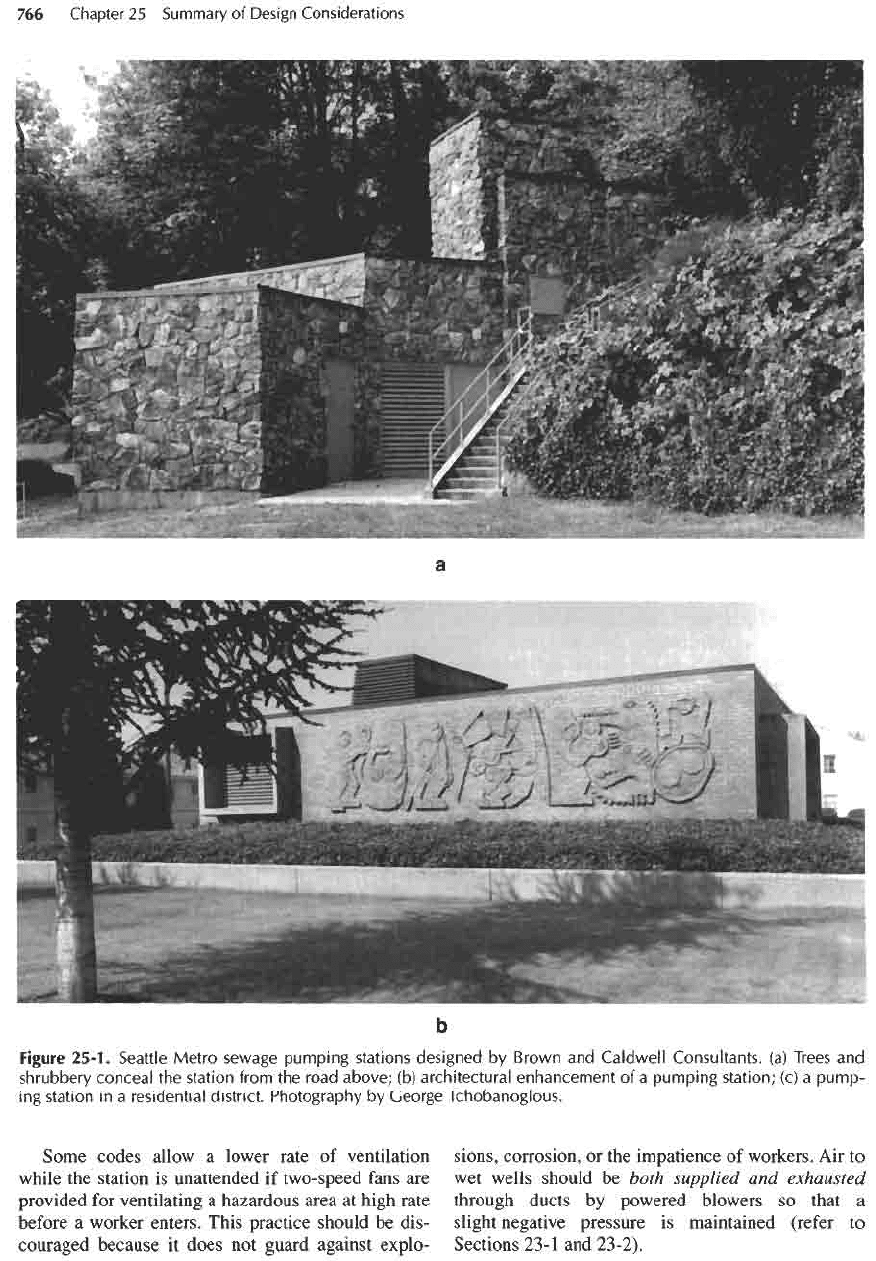
Some codes allow
a
lower rate
of
ventilation
while
the
station
is
unattended
if
two-speed
fans
are
provided
for
ventilating
a
hazardous area
at
high rate
before
a
worker enters. This practice should
be
dis-
couraged because
it
does
not
guard against explo-
sions, corrosion,
or the
impatience
of
workers.
Air to
wet
wells should
be
both
supplied
and
exhausted
through ducts
by
powered blowers
so
that
a
slight negative pressure
is
maintained
(refer
to
Sections 23-1
and
23-2).
Figure
25-1. Seattle
Metro
sewage
pumping
stations designed
by
Brown
and
Caldwell
Consultants,
(a)
Trees
and
shrubbery conceal
the
station from
the
road
above;
(b)
architectural enhancement
of a
pumping
station;
(c) a
pump-
ing
station
in a
residential district. Photography
by
George
Tchobanoglous.
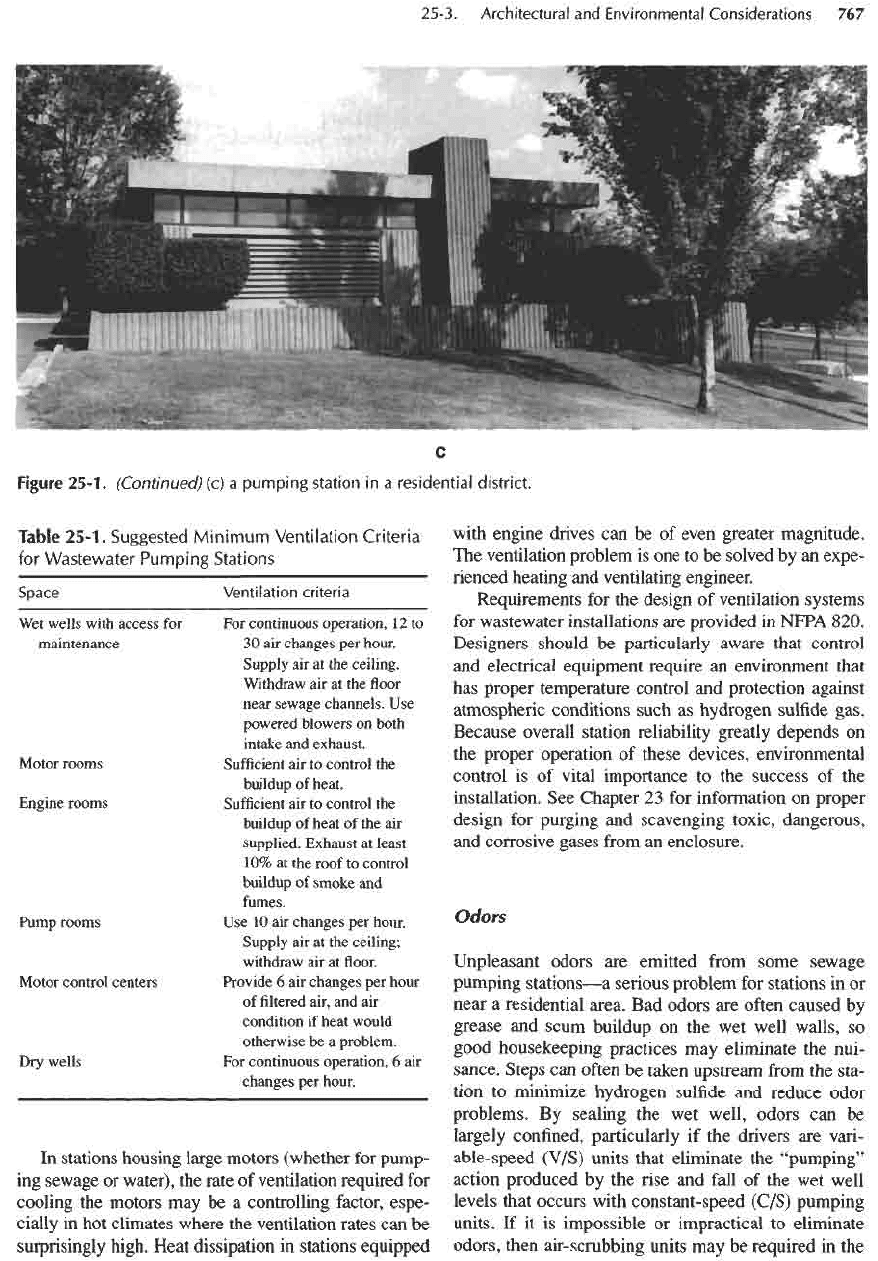
Table
25-1.
Suggested
Minimum
Ventilation
Criteria
for
Wastewater
Pumping
Stations
Space
Wet
wells with
access
for
maintenance
Motor rooms
Engine
rooms
Pump rooms
Motor control centers
Dry
wells
Ventilation
criteria
For
continuous operation,
12
to
30 air
changes
per
hour.
Supply
air at the
ceiling.
Withdraw
air at the floor
near
sewage channels.
Use
powered blowers
on
both
intake
and
exhaust.
Sufficient
air to
control
the
buildup
of
heat.
Sufficient
air to
control
the
buildup
of
heat
of the air
supplied. Exhaust
at
least
10%
at the
roof
to
control
buildup
of
smoke
and
fumes.
Use
10 air
changes
per
hour.
Supply
air at the
ceiling;
withdraw
air at floor.
Provide
6 air
changes
per
hour
of
filtered
air,
and air
condition
if
heat
would
otherwise
be a
problem.
For
continuous
operation,
6 air
changes
per
hour.
In
stations housing large motors (whether
for
pump-
ing
sewage
or
water),
the
rate
of
ventilation required
for
cooling
the
motors
may be a
controlling
factor,
espe-
cially
in hot
climates where
the
ventilation rates
can be
surprisingly
high. Heat dissipation
in
stations equipped
with
engine drives
can be of
even greater magnitude.
The
ventilation problem
is one to be
solved
by an
expe-
rienced heating
and
ventilating engineer.
Requirements
for the
design
of
ventilation systems
for
wastewater installations
are
provided
in
NFPA 820.
Designers should
be
particularly aware that control
and
electrical equipment require
an
environment that
has
proper temperature control
and
protection against
atmospheric conditions such
as
hydrogen
sulfide
gas.
Because overall station reliability greatly depends
on
the
proper operation
of
these devices, environmental
control
is of
vital importance
to the
success
of the
installation.
See
Chapter
23 for
information
on
proper
design
for
purging
and
scavenging toxic, dangerous,
and
corrosive gases
from
an
enclosure.
Odors
Unpleasant odors
are
emitted
from
some sewage
pumping
stations
—
a
serious problem
for
stations
in or
near
a
residential area.
Bad
odors
are
often
caused
by
grease
and
scum buildup
on the wet
well walls,
so
good housekeeping practices
may
eliminate
the
nui-
sance. Steps
can
often
be
taken upstream
from
the
sta-
tion
to
minimize hydrogen
sulfide
and
reduce odor
problems.
By
sealing
the wet
well, odors
can be
largely
confined,
particularly
if the
drivers
are
vari-
able-speed (V/S) units that eliminate
the
"pumping"
action produced
by the rise and
fall
of the wet
well
levels that occurs with constant-speed (C/S) pumping
units.
If it is
impossible
or
impractical
to
eliminate
odors, then
air-
scrubbing
units
may be
required
in the
Figure
25-1.
(Continued)
(c) a
pumping
station
in a
residential
district.
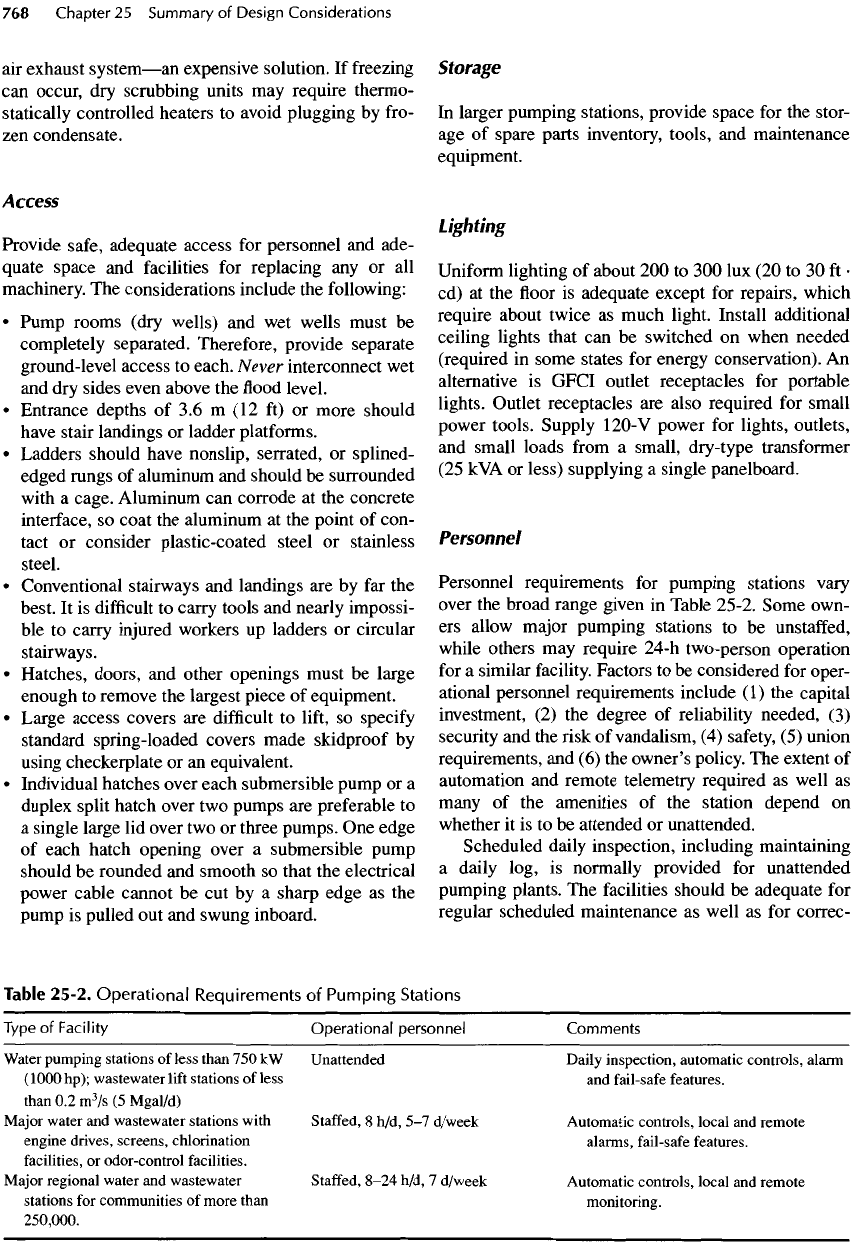
air
exhaust
system
—
an
expensive solution.
If
freezing
can
occur,
dry
scrubbing units
may
require thermo-
statically controlled heaters
to
avoid plugging
by
fro-
zen
condensate.
Access
Provide
safe,
adequate
access
for
personnel
and
ade-
quate
space
and
facilities
for
replacing
any or all
machinery.
The
considerations include
the
following:
•
Pump rooms (dry wells)
and wet
wells must
be
completely separated. Therefore, provide separate
ground-level access
to
each. Never interconnect
wet
and
dry
sides even above
the flood
level.
•
Entrance depths
of 3.6 m (12 ft) or
more should
have
stair landings
or
ladder platforms.
•
Ladders should have nonslip, serrated,
or
splined-
edged rungs
of
aluminum
and
should
be
surrounded
with
a
cage. Aluminum
can
corrode
at the
concrete
interface,
so
coat
the
aluminum
at the
point
of
con-
tact
or
consider plastic-coated steel
or
stainless
steel.
•
Conventional stairways
and
landings
are by far the
best.
It is
difficult
to
carry tools
and
nearly impossi-
ble to
carry
injured
workers
up
ladders
or
circular
stairways.
•
Hatches, doors,
and
other openings must
be
large
enough
to
remove
the
largest
piece
of
equipment.
•
Large access covers
are
difficult
to
lift,
so
specify
standard
spring-loaded covers made skidproof
by
using
checkerplate
or an
equivalent.
•
Individual hatches over each submersible pump
or a
duplex
split hatch over
two
pumps
are
preferable
to
a
single large
lid
over
two or
three pumps.
One
edge
of
each hatch opening over
a
submersible pump
should
be
rounded
and
smooth
so
that
the
electrical
power
cable cannot
be cut by a
sharp edge
as the
pump
is
pulled
out and
swung inboard.
Storage
In
larger pumping stations, provide space
for the
stor-
age of
spare parts inventory, tools,
and
maintenance
equipment.
Lighting
Uniform
lighting
of
about
200 to 300 lux (20 to 30 ft •
cd) at the floor is
adequate except
for
repairs, which
require about twice
as
much light. Install additional
ceiling lights that
can be
switched
on
when needed
(required
in
some states
for
energy conservation).
An
alternative
is
GFCI outlet receptacles
for
portable
lights. Outlet
receptacles
are
also
required
for
small
power
tools. Supply
120-
V
power
for
lights, outlets,
and
small loads
from
a
small, dry-type transformer
(25 kVA or
less) supplying
a
single panelboard.
Personnel
Personnel requirements
for
pumping stations vary
over
the
broad range given
in
Table 25-2. Some own-
ers
allow major pumping
stations
to be
unstaffed,
while
others
may
require 24-h two-person operation
for
a
similar facility. Factors
to be
considered
for
oper-
ational
personnel
requirements include
(1)
the
capital
investment,
(2) the
degree
of
reliability needed,
(3)
security
and the
risk
of
vandalism,
(4)
safety,
(5)
union
requirements,
and (6) the
owner's policy.
The
extent
of
automation
and
remote telemetry required
as
well
as
many
of the
amenities
of the
station depend
on
whether
it is to be
attended
or
unattended.
Scheduled
daily inspection, including maintaining
a
daily log,
is
normally provided
for
unattended
pumping
plants.
The
facilities should
be
adequate
for
regular
scheduled maintenance
as
well
as for
correc-
Table
25-2.
Operational
Requirements
of
Pumping
Stations
Type
of
Facility
Water
pumping stations
of
less than
750 kW
(1000
hp); wastewater
lift
stations
of
less
than
0.2
m
3
/s
(5
Mgal/d)
Major
water
and
wastewater stations
with
engine
drives, screens,
chlorination
facilities,
or
odor-control facilities.
Major
regional water
and
wastewater
stations
for
communities
of
more than
250,000.
Operational
personnel
Unattended
Staffed,
8
h/d,
5-7
d/week
Staffed,
8-24 h/d,
7
d/week
Comments
Daily
inspection, automatic controls, alarm
and
fail-safe
features.
Automatic
controls, local
and
remote
alarms,
fail-safe
features.
Automatic
controls, local
and
remote
monitoring.
